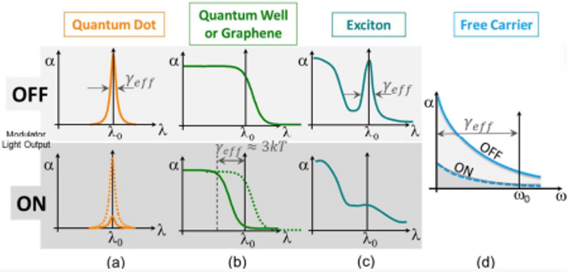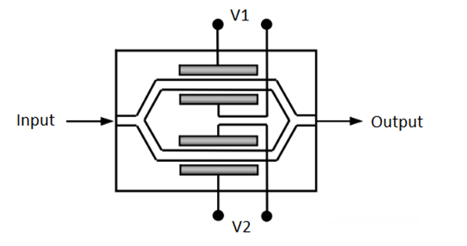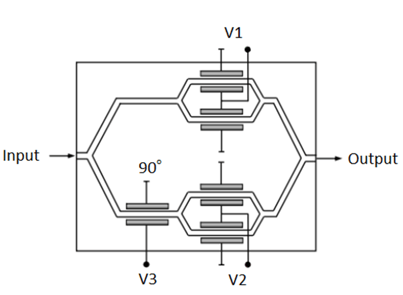Abstract:
This reports explores the design and simulation of photonic modulators using Ansys Lumerical tools. With the increasing demand for high-speed internet and efficient data transmission in various industries, such as telecommunications, data centers, and medical and life sciences, photonic modulators have become increasingly important. However, designing and optimizing photonic modulators can be a challenging and time-consuming process. Ansys Lumerical provides simulation tools that can help to achieve automation, scalability, customizability, and accuracy in the photonic modulator industry. This paper discusses the latest advancements in photonic modulators, including Micro Rings, Mach Zenders, and Electro-absorption modulators (EAMs), and how simulation tools can be used to optimize their design. Additionally, the paper provides a comparison of different types of modulators and their performance metrics. Overall, this paper highlights the importance of simulation tools for the design and optimization of photonic modulators and their role in achieving high-performance optical transceivers.
Introduction:
In today's data-driven world, the demand for faster and more efficient data transmission has placed a significant burden on data centers. The increasing demand for high-speed internet, cloud computing, and emerging technologies such as artificial intelligence and 5G networks require data centers to leverage the latest advances in power and bandwidth optimization. However, electrical I/O bandwidth is a significant bottleneck in data center performance due to channel loss, limited bandwidth, and physical constraints. To overcome these limitations, optical interconnects using photonic modulators have gained importance and become increasingly popular due to their performance advantages over electrical I/O.
Photonic modulators are critical components in optical transceivers and play a critical role in the transmission of data in optical interconnects. The photonic modulator market is expected to grow significantly in the coming years, driven by the need for high-speed internet and efficient data transmission in various industries, such as telecommunications, data centers, and medical and life sciences.
In this whitepaper, we will focus on the simulation of photonic modulators, specifically Micro Rings, Mach-Zehnder, and Electro-absorption modulators (EAMs), using Ansys Lumerical tools, and how they can help to achieve automation, scalability, customizability, and accuracy in the photonic modulator industry. We will discuss the latest advancements in photonic modulator design and how simulation tools, such as Ansys Lumerical, can be used to design and optimize photonic modulators, reducing the transition period and eliminating inefficiencies in the manufacturing process. Furthermore, we will discuss the market trends and the increasing demand for high-performance photonic modulators in various industries such as telecommunications, data centers, and emerging technologies like quantum computing.
Market Analysis of Photonic Transceivers and Modulators: Trends, Growth Drivers, and Competitive Landscape
The market for photonic modulators and transceivers is expected to grow significantly in the coming years, driven by the demand for high-speed internet and efficient data transmission in various industries. The telecommunications industry, in particular, is a major driver of growth, with the increasing adoption of fiber-optic networks and the need for higher bandwidths. In addition, the rise of cloud computing and emerging technologies such as artificial intelligence and 5G networks has placed a significant burden on data centers to provide faster and more efficient data transmission, leading to increased demand for photonic modulators and transceivers.
According to a report by MarketsandMarkets, the photonic modulator market is expected to grow from USD 590 million in 2020 to USD 1,283 million by 2025, at a compound annual growth rate (CAGR) of 16.8% during the forecast period. The report identifies the need for high-performance and cost-effective modulators in data centers and telecommunication networks as the main drivers of market growth. North America is expected to hold the largest market share during the forecast period, followed by the Asia Pacific and Europe.
The report also identifies the increasing use of silicon photonics technology as a major trend in the photonic modulator market. Silicon photonics technology offers advantages such as high integration density, low power consumption, and compatibility with existing CMOS processes, making it an attractive option for the development of photonic modulators and transceivers.
In addition to the telecommunications and data center industries, photonic modulators and transceivers also have potential applications in the medical and life sciences industries. For example, they can be used in biomedical imaging and spectroscopy, as well as in sensing and detection applications.
Overall, the market for photonic modulators and transceivers is expected to grow significantly in the coming years, driven by the need for high-speed and efficient data transmission in various industries. The adoption of silicon photonics technology and the increasing demand for cost-effective and high-performance modulators are expected to be major trends in the market.
An Overview of Optical Transceiver Technology and Industry Advancements
The optical transceiver industry is constantly evolving to meet the ever-increasing demand for faster and more efficient data transmission. Fig. (1) illustrates the key trend for optical transceiver technology, highlighting the challenges faced by pluggable optic beyond 112 Gbs due to large signal losses in copper interconnects. Despite their advantages, such as multi-vendor support, flexibility, and proven operation, it becomes difficult to transmit data farther than a few centimeters at such a high data rate.
Fig. 1 demonstrates the key trends in optical transceiver technology.
To address this challenge, co-packaged optics (CPO) using SiPh technology is expected to achieve 6.4 T by 2030, as seen in Fig. (1). An example of an industry application is Intel's integration of optics directly onto a socketed ASIC using a photonics-electronics hybrid approach. This approach has enabled Intel to deliver a 1.6 Tb/s photonic engine in 2020, compared to the 100 Gb/s pluggable modules. More details on this development can be found in Fig. 2.
Fig. 2: Intel's Co-Packaged Silicon Photonics (SiPh) Pluggable Module: 2020 Demo and Future Prospects.
Several companies, including Cisco, Ayar Labs, and Rockley Photonics, have made similar advances in photonic modulator design, leading to significant growth in the market. The ongoing advancements in optical transceiver technology and photonic modulator design are expected to continue to drive growth in the industry in the coming years.
Basics of Photonic Modulators
Photonic modulators are critical components of optical transceivers, requiring careful consideration in both electronic and photonic design. Ansys Lumerical provides various workflows for designing different types of modulators, including electro-absorption modulators (EAMs), microring modulators (MRMs), and Mach-Zehnder modulators (MZMs).
|
|
Modulator B/W |
Driver Swing |
Thermal sensitivity |
Area |
O band |
|
EAM |
High |
low |
low |
low |
No |
|
MZM |
High |
High |
Low |
High |
Yes |
|
MRM |
High |
low |
High |
Very low |
Yes |
Table 1 provides a useful comparison of three types of photonic modulators, each with their own advantages and disadvantages. MZM offers high bandwidth and a large working area, but it is also bulky and requires a high driver swing. EAM, on the other hand, has high bandwidth and a small working area, but it cannot operate at the O band. MRM has high bandwidth and low power consumption, making it an excellent candidate for co-packaged optics, but it is also thermally sensitive.
To overcome the thermal sensitivity of MRM, several solutions have been proposed, including using materials with higher thermal conductivity or integrating cooling elements into the modulator design. Additionally, simulating and optimizing the design of photonic modulators using tools like Ansys Lumerical can help to identify potential thermal issues and optimize the design for improved performance and reliability. Overall, choosing the right photonic modulator for a particular application requires careful consideration of the trade-offs between modulator bandwidth, power consumption, thermal sensitivity, and other important metrics.
Design and Simulation of Electro-Absorption Modulators with Ansys Lumerical
Electro-absorption modulators (EAMs) are essential components of optical transceivers, allowing for efficient and precise modulation of light. By altering the bandgap of the semiconductor PIN structure with an external voltage, the absorption properties of EAMs can be modified through the Quantum Confined Stark Effect (QCSE). The static extinction ratio of an EAM is defined by the absorption coefficient and the confinement factor, which represents the overlap of the optical mode with the active layer. Static extinction ratio of EAM can be defined as follow:
(1)
absorption coefficient α is dependent on material properties. confinement factor is a power fraction representing the overlap of the optical mode (described by U(x, y)) with the active layer
(2)
There are various design schemes for EAMs, including using Quantum Dot(QD), Quantum Well (QW), Graphene, Exciton, and Free carrier, as shown in Fig.3. The absorption properties of EAMs can be manipulated based on the design scheme, where the absorption curve may shift or decrease.

Fig.3 different schemes of modulator design(Vol. 26, No. 12 | 11 Jun 2018 | OPTICS EXPRESS 15451)
To design EAMs, Ansys Lumerical provides various workflows, including using Lumerical Mode to calculate modal properties and Lumerical Multiphysics to solve Poisson, Continuity, and drift-diffusion equations. Lumerical MQW can be used to solve Schrodinger, gain, and spontaneous emission problems. By converting the design to a Lumerical interconnect, the time and frequency analysis of the circuit can be analyzed.
Fig.4 Lumerical workflows
The simulation of GaAS-In GaAs EAM can be achieved through the following videos:
Photonic Modulator Design and Simulation (Part1- theory of Electro absorption modulators)
Photonic Modulator Design and Simulation (Part2- Lumerical Mode)
Photonic Modulator Design and Simulation (Part3- Lumerical Charge)
An additional example can be found in Ansys resources, demonstrating the modeling and simulation of a Germanium-Silicon (GeSi) EAM on Silicon-on-insulator (SOI). The simulation uses CHARGE and EME solvers, while the device's compact model is created with INTERCONNECT. Simulated EAM performance metrics include dark current, photocurrent, s-parameters, and bandwidth. This example follows the same workflow as the previous one. For further information, please refer to the following link: Electro-absorption modulator – Ansys Optics.
Electro-absorption modulator – Ansys Optics
EAMs are a critical component in the development of high-performance optical transceivers, and Ansys Lumerical provides powerful simulation tools for their design and optimization. By leveraging these tools, researchers and engineers can develop cutting-edge EAM designs for a variety of applications.
Micro Ring Modulator (MRM):
In silicon modulators, ring resonators have played a very prominent role. Ring resonators consist of closed loop optical waveguides that create a resonance for wavelengths equal to the optical path length. In general, many wavelengths satisfy this condition, leading to multiple resonances in a ring. Over the past few years, microring resonator modulators have attracted significant scientific and technological attention due to their compact footprint and potential for low drive voltages.
Designing a micro ring modulator involves a series of simulations and calculations. Ansys Lumerical provides a comprehensive workflow for simulating the performance of MRM. Firstly, the MRM S-parameters are calculated using the Lumerical FDTD. Then, modal parameters such as effective index, group index, and loss for the undoped waveguides in Lumerical Mode are determined. Lumerical Charge is used to study charge distribution at different applied voltages. Finally, doped MRM is simulated in Lumerical Mode to determine how the charge distribution affects the effective index.
Once the previous steps have been completed, a Lumerical interconnect calculates the transmission, free spectral range (FSR), and bandwidth of MRR based on the results. The INTERCONNECT element library includes phase shifters, waveguides, and couplers that can be combined to form a ring modulator. This composition of primitive elements makes it easy to define new compact models using arbitrarily complex modulator sub-circuits. The INTERCONNECT element library also includes a primitive element that facilitates the design of large scale photonic integrated circuits.
To further understand the MRM design and simulation process, Ansys provides several resources such as the following video and webpage links:
Ring modulator time domain (INTERCONNECT) – Ansys Optics
Photonic modulator design and simulation using Ansys Lumerical-Youtube
By utilizing the Ansys Lumerical workflow and resources, designers can accurately simulate and optimize the performance of micro ring modulators for various applications.
Design and Simulation of Mach-Zender Modulators (MZMs) with Ansys Lumerical
Mach-Zehnder modulators (MZMs) are a type of electro-optic modulator that can be classified into two types: forward-biased PIN diodes and reverse-biased PN diodes. The former is easier to fabricate and has a larger refractive index change, but suffers from a high carrier recombination rate. The latter is faster, consumes less power, modulates the depletion region, but has small index changes and higher optical losses.
To determine the performance metrics of an electro-optic modulator such as the VπLπ, insertion loss, and extinction ratio, its modulation response must be analyzed. The effective index of the waveguide can be used to simulate the component's electrical and optical response. Ansys Lumerical provides a simulation environment that can simulate the effective index as a function of applied bias voltage. The simulation workflow includes simulating the charge profiles, calculating the slab resistance and PN junction capacitance, and determining the refractive index change relative to undoped silicon.
The simulation concludes with a compact model circuit simulation in Ansys INTERCONNECT of a traveling wave Mach-Zehnder modulator. This simulation incorporates electrical, optical, and RF components and provides results such as relative phase shift, optical transmission, transmission line bandwidth, and eye diagram. These results are key performance metrics for MZMs, which can be used in various applications, such as constructing QAM signals for coherent transceivers.
MZM modulators comprise a Y branch divider, two arms, and a Y branch combiner, as shown in the figure below.

To achieve amplitude modulation, the optical signal is equally divided into two parallel arms and then independently phase-modulated using a differential RF signal before being combined again in a push-pull operation. Modulating both arms with a differential signal is preferred over modulating one arm, as it is more efficient and requires a Vπ/2 signal on each side instead of a Vπ on one arm. To construct QAM signals for coherent transceivers, two MZMs connected in parallel are required, with one arm requiring a 90-degree shifter. MZMs typically comprise many identical segments, with some models using up to 50 segments. To simulate an MZM, one can use HFSS, an EM tool from Ansys, to simulate one or two segments. Using Circuit Designer, a circuit tool from Ansys, many copies can be cascaded in parallel to construct a complete MZM modulator.
For more information on this type of modulator, please refer to the following links:
Traveling Wave Mach-Zehnder Modulator – Ansys Optics
PIN Mach-Zehnder modulator – Ansys Optics
Calculating modulation response - MZM example – Ansys Optics
Conclusion:
Photonic modulators are critical components in optical transceivers and play a vital role in data transmission in optical interconnects. To meet the increasing demand for high-speed internet, cloud computing, and emerging technologies such as artificial intelligence and 5G networks, photonic modulators have become increasingly popular due to their performance advantages over electrical I/O.
Ansys Lumerical provides various workflows for designing different types of photonic modulators, including electro-absorption modulators (EAMs), microring modulators (MRMs), and Mach-Zehnder modulators (MZMs). Simulation tools like Ansys Lumerical can help to design and optimize photonic modulators, reducing inefficiencies in the manufacturing process.
The photonic modulator market is expected to grow significantly in the coming years, driven by the need for high-performance and cost-effective modulators in various industries, such as telecommunications, data centers, and medical and life sciences. Ansys Lumerical provides powerful simulation tools for the design and optimization of photonic modulators, enabling researchers and engineers to develop cutting-edge designs for a variety of applications.
Mar 1, 2023 7:31:27 AM
